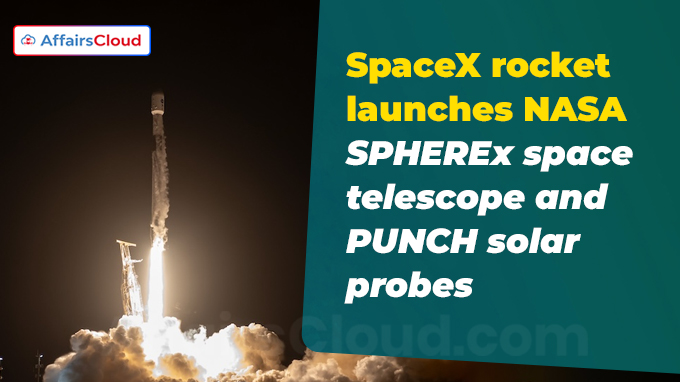 On March 11, 2025, the National Aeronautics and Space Administration (NASA) launched two missions Spectro-Photometer for the History of the Universe, Epoch of Reionization and Ices Explorer (SPHEREx) and Polarimeter to Unify the Corona and Heliosphere (PUNCH) aboard a SpaceX Falcon 9 rocket from Vandenberg Space Force Base, California, the United States America (USA).
On March 11, 2025, the National Aeronautics and Space Administration (NASA) launched two missions Spectro-Photometer for the History of the Universe, Epoch of Reionization and Ices Explorer (SPHEREx) and Polarimeter to Unify the Corona and Heliosphere (PUNCH) aboard a SpaceX Falcon 9 rocket from Vandenberg Space Force Base, California, the United States America (USA).
- The missions aim to study cosmic evolution and solar phenomena.
SPHEREx: Mapping Cosmic History and Life’s Ingredients:
SPHEREx is a space telescope managed by NASA’s Jet Propulsion Laboratory (JPL) in Pasadena, California to survey the entire sky in 102 wavelengths of infrared light, invisible to the human eye.
Key objectives include:
i.Create a three dimensional(3D) map of 450 million galaxies and 100 million stars to study cosmic inflation and the universe’s rapid expansion post-Big Bang.
ii.Scan the entire sky four times in 102 infrared wavelengths to identify water, carbon dioxide(CO2), and organic molecules in interstellar clouds.
iii.Collaborate with the James Webb Space Telescope (JWST) to link broad sky surveys with detailed observations.
Technical Details:
- Orbit: 404 miles (650 kilometres, km) above the Earth in a Sun-Synchronous Orbit(SSO), avoiding sunlight interference.
- Duration: one-month calibration phase then Over two years for capturing 600 daily images
PUNCH: Tracking Solar Wind and Space Weather:
PUNCH, led by Texas(the USA) based Southwest Research Institute(SwRI), comprises four suitcase-sized satellites to study the Sun’s outer atmosphere (corona) and solar wind.
- One satellite carries a coronagraph, the Narrow Field Imager developed by the U.S Naval Research Laboratory, that images the Sun’s corona continuously. The other three carry SwRI-developed Wide Field Imagers, designed to view the very faint outermost portion of the solar corona and the solar wind itself.
- Each spacecraft includes a camera, developed by the United Kingdom(UK) based RAL Space, to collect three raw images, through three different polarizing filters, every 4 minutes. In addition, each spacecraft will produce a clear unpolarized image every 8 minutes, for calibration purposes.
Key goals include:
i.Observing the transition of the corona into solar wind, which influences space weather affecting Earth’s satellites and power grids.
ii.Tracking Coronal Mass Ejections (CMEs) to improve space weather forecasts.
iii.Operating during solar maximum (2025–2026), a period of heightened solar activity.
Technical Details:
- Instruments: Equipped with polarizing filters to create 3D maps of solar wind and corona.
- Orbit: Sun-synchronous, ensuring continuous solar observation.
- Collaboration: Complements NASA’s Parker Solar Probe by providing contextual data for close-up solar studies.
- Duration: Two years after the 90-day commissioning period to synchronize its satellites as a single instrument.
Mission Timelines and Outcomes:
SPHEREx: Begins its prime mission in April 2025, focusing on galaxy distribution and life-supporting molecules.
PUNCH: Operational by July 2025, analyzing solar wind dynamics until 2027.
Expected Contributions:
SPHEREx: Insights into cosmic inflation and interstellar chemistry.
PUNCH: Enhanced space weather forecasting models.
About National Aeronautics and Space Administration(NASA):
Administrator – Janet Petro (Incumbent)
Founded – 1958
Headquarters – Washington, D.C., the United States of America (USA)




